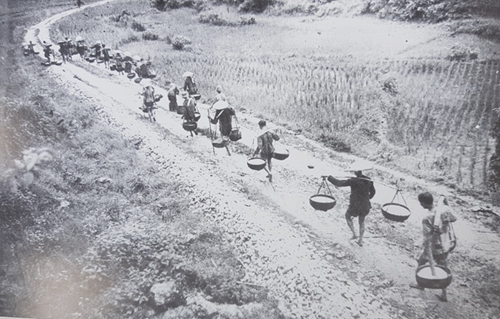In July, 1953, the Prime Minister issued a decision to establish the Central Council for Supplies for the Front to direct central and local agencies and sectors to mobilize human and material resources to ensure logistics supplies for the campaign.
    |
 |
|
Transporting food to Dien Bien Phu Front (A filed photo) |
Promoting synergy in ensuring logistics
According to initial operational plan, the projected materials for the Dien Bien Phu Campaign were 434 tons of ammunition, 7.73 trillion tons of rice, 465 tons of dry food, and hundreds of tons of salt. However, the amount of ammunition increased by nearly 3.5 times, and rice nearly doubled when the combat plan was shifted to the “Steady combat, Steady advance” strategy. In terms of food supplies alone, on average, the campaign used more than 140 tons per day to support the forces in different places, including those in Dien Bien Phu, and it required more than 3,000 conscripted laborers to transport this large amount of food supplies to the battlefields. The food transportation was challenging since the battlefields were 600km away from the rear. Treacherous mountainous terrains, damaged road infrastructure, unfavorable waterways, harsh weather conditions, sparse population, and difficult economic conditions were added to the challenges. Meanwhile, the enemy fiercely attacked key routes to prevent our reinforcements and supplies for the Dien Bien Phu battlefield.
Therefore, ensuring logistics supplies became an extremely challenging task at that time. The supplies councils at all levels collaborated with state economic and financial organizations to provide timely human and material support for the Dien Bien Phu Campaign. The council launched the largest ever movement to mobilize human and material support from temporarily occupied areas and liberated zones of North of Region 4, the Northernmost and the Northwestern regions.
The supplies councils at all levels, in collaboration with the logistics force, mobilized a total of more than 260,000 conscripted laborers, over 20,000 pack-bikes, 17,000 horses, more than 11,800 boats and rafts, and 628 trucks to transport goods, weapons, and ammunition to serve the campaign. The total weight of the supplies reached up to 20,000 tons. Thanks to the support of supplies councils at all levels, the logistics work was successfully accomplished, contributing to the complete victory of the Dien Bien Phu Campaign.
Taking full advantage of on-the-spot resources
The Dien Bien Phu Campaign took place far away from the strategic rear and the area with rough mountainous terrains, poor transport infrastructure, and harsh weather conditions. Since the enemy frequently accelerated attacks to destroy supply routes, causing significant challenges for logistics operations. Therefore, taking full advantage of on-the-spot resources was a crucial measure, allowing the rear to focus on other aspects that the on-the-spot forces were not able to handle.
The supplies council mobilized a large number of conscripted laborers, vehicles, rice, and food from the ethnic minority groups in the Northwestern region. By combining logistics support from locals and central agencies, the Central Council for Supplies for Front contributed to creating synergy in ensuring logistics for the armed forces, thus ensuring timely, pro-active, and sufficient logistics support for those in operational areas.
The people of Lai Chau province alone contributed more than 2,660 tons of rice, 226 tons of meat, 210 tons of vegetables, and 348 horses to the campaign. The people of Son La province gave over 3,600 tons of rice, 130 tons of pork, tens of tons of buffalo and cattle meat, contributed over 1 million working days, and provided horses, rafts, anti-mud materials, and materials for road and bridge construction.
Based on the Council’s organization in providing supplies for the Dien Bien Phu Campaign, various similar models were creatively established during the resistance war against U.S. imperialists. It is worth mentioning the defense supplies board and the traffic regulation board in key provinces of Region 4; the supplies councils for the front in Southern provinces; the central council for supporting the front; and the Southern support council. These models aimed to motivate, mobilize, and effectively utilize human and material resources to ensure the victory of campaigns. These unique and creative models still hold their value and should be applied and further developed to suit the current conditions.
Translated by Tran Hoai